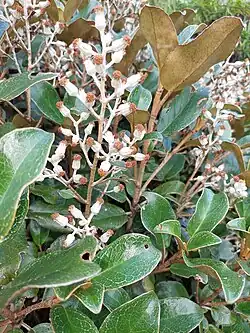Brachyglottis elaeagnifolia
| Brachyglottis elaeagnifolia | |
|---|---|

| |
| Scientific classification | |
| Kingdom: | Plantae |
| Clade: | Tracheophytes |
| Clade: | Angiosperms |
| Clade: | Eudicots |
| Clade: | Asterids |
| Order: | Asterales |
| Family: | Asteraceae |
| Genus: | Brachyglottis |
| Species: | B. elaeagnifolia
|
| Binomial name | |
| Brachyglottis elaeagnifolia | |
| Synonyms | |
|
Senecio elaeagnifolia | |
Brachyglottis elaeagnifolia is a species of flowering plant in the family Asteraceae. It is endemic to New Zealand,[1] where it is mostly limited to the North Island.[2]
Description
Brachyglottis elaeagnifolia is a shrub which grows to a height of 3 metres. The branches are grooved and the smaller branches and petioles are coated in whitish or pale brownish hairs. The leathery leaves are widely lance-shaped to oblong and up to 9 centimetres long. The upper surfaces are shiny and hairless and the undersides have silvery whitish or brownish hairs. The inflorescence is a panicle of woolly flower heads containing disc florets. The fruit is an achene 1 to 2 millimetres long with a pappus of barbed white hairs up to 5 millimetres long.[1]
Distribution and habitat
Volcanic debris on Mount Taranaki has been colonized by this species, which occurs in dense stands up to 100 years old.[3]
It is found widespread in the mountains in the North Island in montane shrubland. It can also be found in the Marlborough Sounds, South Island, in open upland forest. [4]
References
- ^ a b Brachyglottis elaeagnifolia. NZ Flora.
- ^ "Brachyglottis elaeagnifolia". Germplasm Resources Information Network. Agricultural Research Service, United States Department of Agriculture. Retrieved 23 January 2018.
- ^ Clarkson, B. D. (1990). A review of vegetation development following recent (<450 years) volcanic disturbance in North Island, New Zealand. New Zealand Journal of Ecology 14, 59-71.
- ^ "Field Guide to New Zealand's Native Trees". www.wikidata.org. Retrieved 19 October 2024.